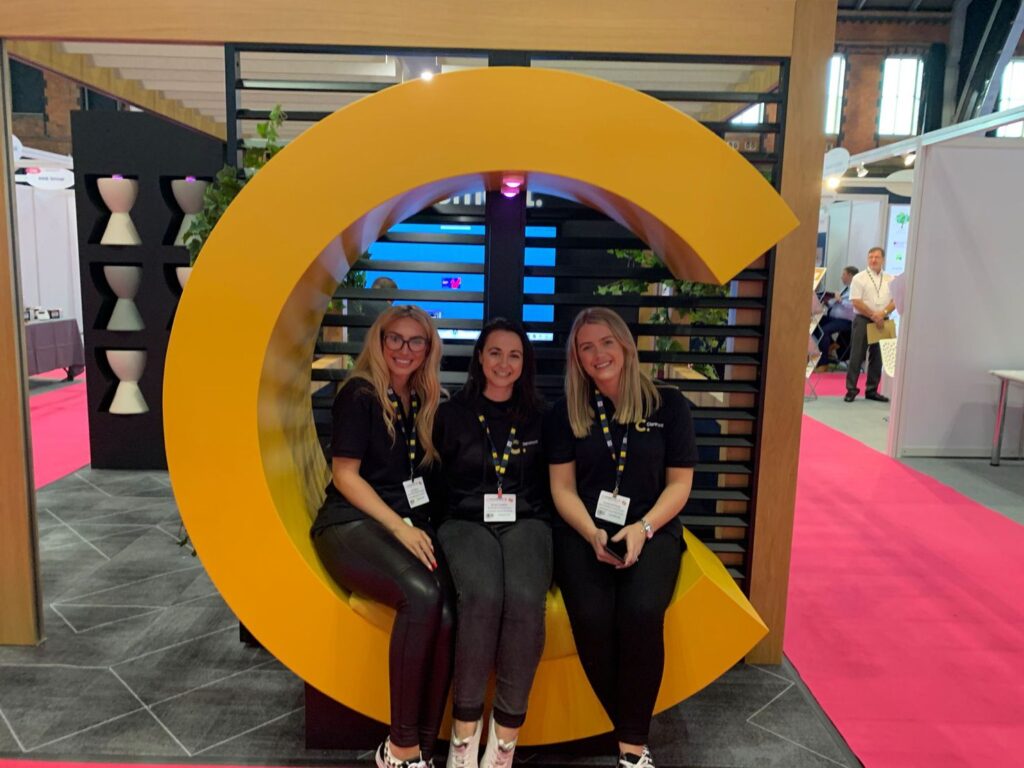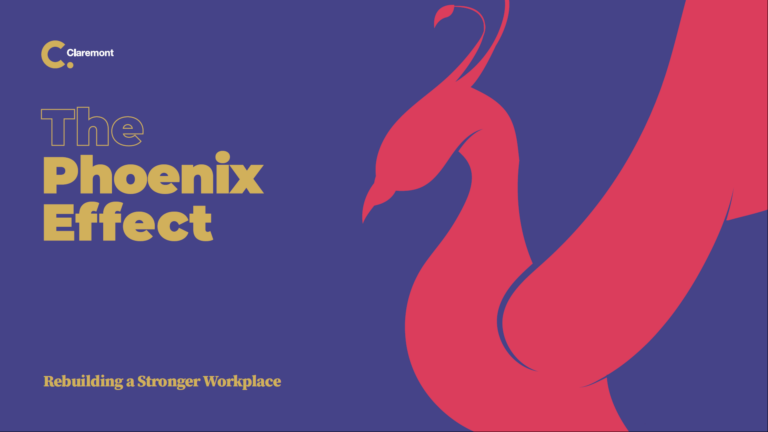
Housing 2021; our first big event in nearly two years. Walking around the Exhibition Hall at Manchester Central, there’s a real dynamic energy, a buzz that’s been absent for the past 18 months.
Based on Stand D66, the Claremont team recreated a miniature workspace, with our accent piece; the famous Big Yellow C – it’s no wonder there’s been a whole lot of buzz around what we do and who we are!

With plenty of insightful conversations with people across the length and breadth of the housing sector, we felt it best to share some of the common questions, challenges, and concerns that we’ve been hearing, along with some of our thoughts:
We know we have to do something, we just don’t know what!
This really is a common challenge in the current environment; we’re in a constant state of flux, with the pandemic still looming over us, everyone having had very unique experiences over the past 18 months, and organisations beginning to encourage colleagues back to the office. Long-term, it would be misleading for us to tell you exactly where the workplace was heading, but we can tell you that if you don’t make any changes now, you are likely to lose an opportunity where your people are open to a both behavioural and environmental changes in the workplace, and it is likely you’ll be throwing money away at unused spaces. We can help you dig deep to understanding what both your people want, and what your organisation needs, in order to begin a journey of change and futureproof your workspaces, and this doesn’t have to cost the earth.
We own our building, but we don’t know what to do with any surplus space?
In life, if we have the space, we tend to fill it; whether it’s the spare bedroom or loft space at home, or the car on a family holiday, given the space, we’ll squeeze something in. The same can be said for office spaces. Historically, this may have worked when colleagues were expected to be in the office 5-days per week, but throughout the experience of Covid-19, we’ve realised that people can be productive working from home, therefore we need a lot let desk space, a bit more social and collaboration space, and in general, a little less space overall. Now, we can come in, engage with people across your business, from senior to junior colleagues, and advise on how much space you actually require in your workplace, which will begin your process of understanding how much surplus space you may need. From there, a business decision may be made to make a community space, open to your customers and partners with this additional space, or it may be decided to moth-ball the space until it becomes feasible to lease or sell it. Either way, we can offer advice and options in order for you to make an informed decision that is best for your organisation.
Do teams still have their home bases in order to work closely together?
This is an interesting question, and one in which there is no golden-bullet answer. It all depends on your expectations for colleagues to return to the workplace, alongside their freedom as to where and when they work. On average, we’re finding that people would like to be in the office 2-3 days per week. Now, if this average fits your organisation, it would be utterly disproportionate to allocate a desk to each individual. Therefore, creating a ‘neighbourhood’ area, where colleagues and their teams could call their ‘base’, the place where they can expect to find their team-mates when they are in the office together. Although individuals don’t have their own allocated desk, this is an area in which they feel a sense of belonging, a sense of home.
For organisations who are expect their colleagues to be in the office more less than 2-3 days per week, however, it would make less sense to have a universal neighbourhood approach, where all departments have their own base. In this instance, the most efficient use of space is likely to provide a series of both bookable and non-bookable desks, where managers of a team are able to book a bank of desks for colleagues who they know are coming in to work closely together, or a system that allows users to observe who has booked in and where, so that they are able to sit in close proximity to the person they are coming in to work close to. As mentioned at the beginning, there is no golden-bullet solution, and it will involve a deeper understanding of your organisation in order to recommend a solution that best suits you.
Dissonance between the views of the C-suite executives and the operative colleagues on the ‘shop floor’
We’ve heard from some organisations where the board group, typically all of a similar demographic with a comfortable home-working set-up, are unable to connect with the requirements from the rest of the organisation. It’s no surprise that everyone has had a different experience during the pandemic, but early career individuals and senior board members couldn’t be further apart in their typical experiences. For some, particularly those early career colleagues, they feel as though progression in their career has seen an 18-month setback, that the lack of connectivity and visibility with others in the organisation has caused damage to their prospects with their organisation, while the isolation has caused harm to their mental health. These colleagues are craving the collaboration, socialisation, and ambience of working from a communal workspace. C-suite level executives, the colleagues calling the shots in the organisation, however, have largely had a slightly different experience. They’ve typically been able to work in a more comfortable environment from home and enjoyed the flexibility that home-working has to offer, particularly to work-life balance without a commute. Whilst they may miss the connectivity to the organisation, they are less likely to find it as detrimental to their own success and career progression than some of their more junior colleagues.
Without meaningful engagement with colleagues across the board, the experience of the C-suite is likely to drive the short-term future decisions regarding the use of the workplace; possibly the decision to keep the office closed until there is assurance that it is categorically safe to return, or even the decision to force colleagues back to 5 days per week so they can return to a presenteeism culture. True engagement with your colleagues, coupled with a culture of collaboration, psychological safety, and trust is what will close the divide between your C-suite individuals and your most junior colleagues, creating a mutually beneficial and supportive approach.
As we turned our lights off the Big Yellow C on the third and final day of Housing 2021, we were really heartened to see the desire for change within the housing sector; the realisation that the sudden demand for technological advances in March 2020 lead to an overnight enabling of agile and flexible working, and now that expectations of colleagues may have shifted, their workplace must catch up, both for cultural advancements as well as commercially.

See how we could help with your new office interior design or office design and build project here
Get in touch
We love nothing better than talking all things workplace and design – got a question, potential project or just need some guidance?
Drop us a note…





